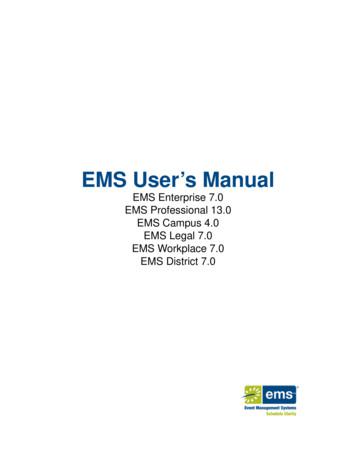Environmental Management System (EMS) As A Climate Change .
Environmental Management System (EMS)As A Climate Change Management Tool2010 Sustainability SummitJune 9, 2010
Why are we here today? Introduce Metro’s EMS process as a ClimateChange Management Tool Engage and Identify Opportunities ofImprovement and Collaboration Spread the word
Outline Metro’s Environmental and SustainabilityProgram Environmental Management System Indicators Accomplishments Current Studies Questions/Discussion
Metro’s Environmental Program Four-pronged approach to environmental protection andenhancement––––Environmental clearanceRemediation, restoration and enhancement of impacted sitesAccounting and reduction of environmental liabilitiesDevelopment, implementation and promotion of sustainable planning,construction, operations, and procurement practices Establish sustainability criteria and standards for all new busand rail extension projects Reduced financial obligations andexposure Create value through more efficientoperations Leads to our overall sustainability
What is EMS? Environmental Management SystemCollection of best practices to ensureenvironmental compliance at all levelsof organization Based on ISO 14001 standard– ISO 14001 compliant vs. ISO 14001 certified Cited by the FTA across the nation as any transitproperty’s clearest commitment to environmentalcompliance and stewardship
Major Elements of EMS? Environmental PolicyIdentification of Environmental Laws and RegulationsIdentification of Environmental IssuesDevelopment of Targets and ObjectivesIdentification of Resources, Roles and ResponsibilitiesIdentification of Training RequirementsPLANDevelopment of Internal and External CommunicationsDocumentation to Develop, Review, and Revise ProceduresDevelop Document ControlControl and Distribution of RecordsDevelop Policies and Procedures to Address Environmental IssuesEmergency PreparednessMonitoring and Measurement of ProgressEvaluation of Environmental ComplianceIdentification of Non-Conformity to EMS processInternal Audit to Ensure EMS ComplianceManagement ReviewACTCHECKDO
Metro EMS Efforts Basis is the Metro-Board adoptedEnvironmental PolicyEMS as the tool to ensure environmentalcompliance and sustainabilityFTA-assisted effortTraining at VA Tech for selected personnelDesignation of Local resources to ImplementEMS at Facility LevelFTA Report
Sustainability Indicators and EfficiencyTwelve sustainabilityindicators historicallyevaluated Derived from The GlobalReporting Initiative (GRI) Inputs (energy, water,materials) Outputs (emissions,effluents, waste)Rail Propulsion Power
Data and Analysis – Facility Electricity Use9
Data and Analysis – Water UseWater Use Decreased in 2009
Data and Analysis – Greenhouse Gas
Transit Related Protocols APTA Climate Change Working GroupRecommended Practice for QuantifyingGreenhouse Gas Emissions from Transit(August 2009)––––Basis: Climate Registry ProtocolVehicle Miles Travelled OffsetCongestion Reduction OffsetLand Use Multiplier Co-Benefit OffsetRecommended Practice for Climate ActionPlanning –Will be completed in August 2010
Accomplishments To Date Identified the most pressing environmentalissues and began addressing themDevelopment of procedures where nonepreviously existedComplete EMS training program– Sustainability Awareness Training– Environmental ManagementSystem Awareness Training
Accomplishments To Date Strengthen existing programs––––– Monthly environmental inspection and reportingStormwater and wastewater programsUnderground and aboveground storage programBattery and Universal Waste DisposalRecycling ProgramDevelop an EMS Awareness videoDevelop Contractor Management documentsDevelop EMS campaign documents
Accomplishments To Date Awareness at executive management level ofenvironmental issuesDevelopment of Environmental InformationManagement System [EIMS]Identification and implementation of costsaving ideasRobust Bottoms Up/Top DownApproach
Related Documents and Efforts Environmental Policies––––– Environmental PolicySustainability and Energy PolicyWater Use and Conservation PolicyConstruction and Demolition Debris Recycling andReuse PolicyEnvironmental Liabilities Assessment and ReportingPolicyInclusion of sustainability principles inOperations and Design Criteria––Planning, Construction, Operations, ProcurementBusway and Heavy Rail and Light Rail
Related Documents and Efforts Pilot LEED-Existing Buildings Operations andMaintenance project at GatewayEnergy Partnership Opportunities ––– CaltransUtilitiesEnergy Services CorporationsGrants– Electric Vehicle Plug-in Stations Grant: CaliforniaEnergy Commission– Wayside Energy Storage System: ARRA– SCE Cool Planet Grant Climate Registry Membership and Support
On-Going Studies Greenhouse Gas Emissions Reduction StrategiesCost-effectiveness StudyWater Action PlanEnergy Management and Conservation PlanFacility-wide Environmental Baseline AnalysisEnergy Audits for all FacilitiesOrange Line Bike Path Cost-Effectiveness StudyRail Station Bike Counts
Recognitions and Cost-Savings National Training Institute as a National Model USDOT, FTA, and APTA as a model effort United Nations International Case Study for Current and Projected Cost-Savings in all EMS andSustainability Efforts: about 2M per yearProgramsustainability implementation by a transit agency
Why are we here today? Introduce Metro’s EMS process as a ClimateChange Management Tool Engage and Identify Opportunities ofImprovement and Collaboration Spread the word
Questions/DiscussionCris B. Liban, D.Env., P.E.p: 213/922-2471e/m: libane@metro.netwebsite: www.metro.net/sustainabilityhotline: 213/922-1100
Metro’s Environmental Program Four-pronged approach to environmental protection and enhancement – Environmental clearance – Remediation, restoration and enhancement of impacted sites – Accounting and reduction of environmental liabilities – Development, implementation and promotion of sustainable planning,
EMS API Reference Guide 2012 Dean Evans & Associates, Inc. CONFIDENTIAL 20 Aug 2012 9 EMS Professional customers – enter “EMSData” EMS Workplace, EMS Campus, EMS Enterprise, EMS Legal and EMS District customers - typically named “EMS” 9.
Ed Hill, Senior EMS Coordinator, Kern County EMS Kara Davis RN, EMS Systems Director, NorCal EMS Chris Clare RN, Data Systems Manager, Los Angeles County EMS . California EMS System Core Quality Measures 4 Table of Contents EMS System Core Quality Measures Project
EMS User’s Manual EMS Enterprise 7.0 EMS Professional 13.0 EMS Campus 4.0 EMS Legal 7.0 EMS Workplace 7.0 EMS District 7.0
County EMS Agency Field Operations Guide An operational guidance document for EMS Agency Personnel, EMS Duty Chief, EMS Commander, and EMS Director REFERENCE #817 Revised November 2008 Santa Clara County Emergency Medical Services Agency 976 Lenzen Avenue San Jose, California 95126 1. . EMS field units (EMS 2-6/Squad1),
- 5 - continuing through NHTSA’s Uniform Prehospital EMS Dataset (1994), the EMS Agenda for the Future (1996), the EMS Education Agenda for the Future: A Systems Approach (2000), the National EMS Research Agenda (2001), the National EMS Information System (2001), the Rural and Frontier EMS Agenda for the Future (2004), the Trauma S
Recommendation: EMS awareness training to be mandatory for all staff in 2015/16. EMS Management Review 2015/16 Page 7 of 9 www.naturalresourceswales.gov.uk Annex 1 . EMS Management Review 2015/16 Page 8 of 9 www.naturalresourceswales.gov.uk Annex 2 Internal EMS nonconformity review 2013/15 0 10 20 30 40 50 60 70 80
an Environmental Management System (EMS) that is founded on the principles of our respective Environmental Policy. The purpose of the EMS is to sustain and enhance mission readiness and access to training areas through effective and efficient environmental management. The EMS emphasizes that the authority and principal
The EMS Workforce Guidelines document foundation is in both the EMS Workforce Assessment and the EMS Workforce Agenda. The primary objective of the EMS Workforce Assessment was to, “address issues relevant to the process of workforce planning.” 8 The EMS Workforce Assessment provides a listing of 12 critical policy issues























